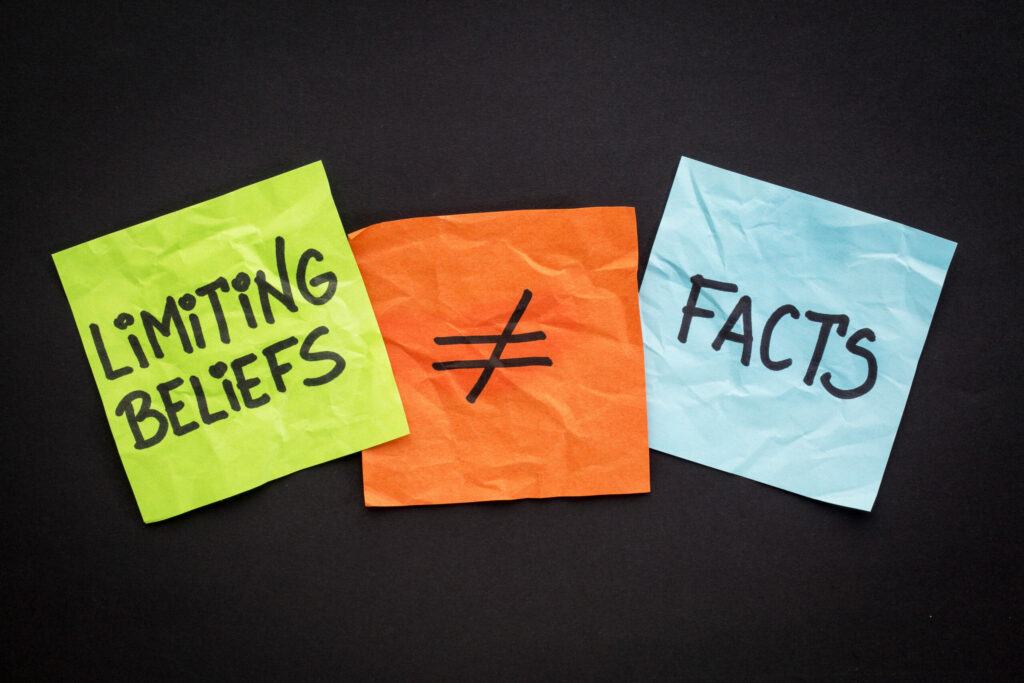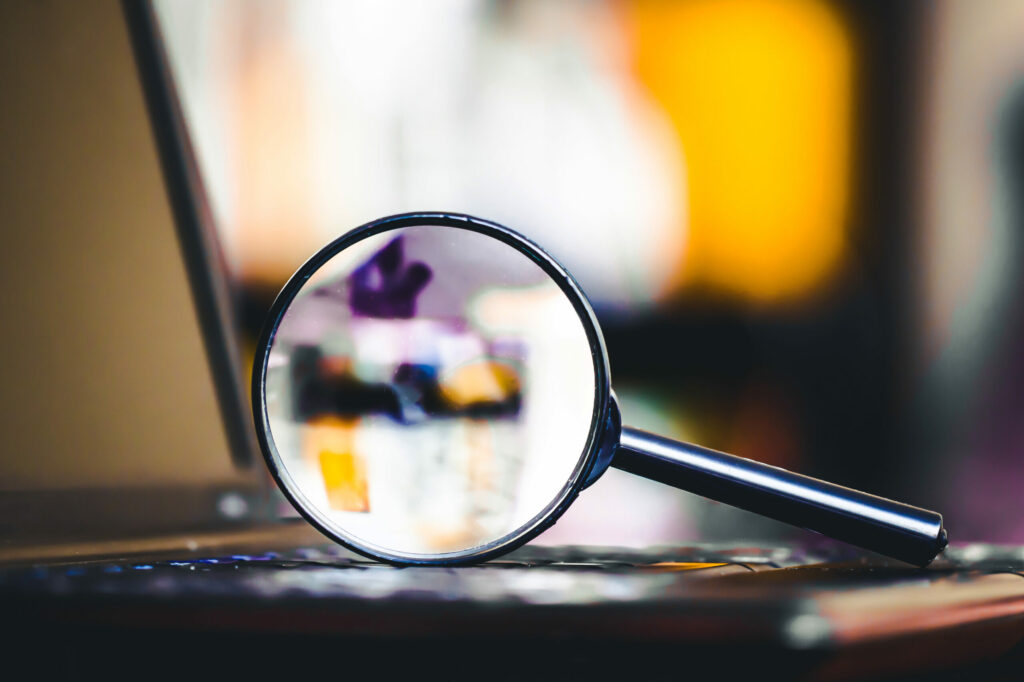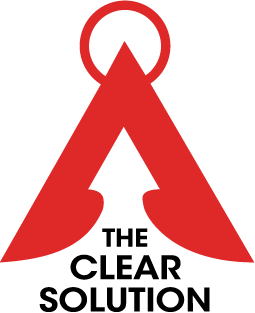Introduction
In our journey towards personal growth and self-improvement, one of the most significant obstacles we often encounter are our own limiting beliefs. These deeply ingrained perceptions about ourselves and our capabilities can significantly hinder our progress and potential. Limiting beliefs are those nagging thoughts that whisper we’re not good enough, capable enough, or deserving enough to achieve our dreams and aspirations. They are the silent saboteurs of success, lurking in the shadows of our minds, often unrecognized yet powerfully influential.

But where do these beliefs come from? According to the insights from the “Balance Baseline Guidebook,” our limiting beliefs are usually formed from past experiences and thoughts that have solidified over time into perceived truths. These beliefs are not just fleeting thoughts; they become embedded in our psyche, influencing our actions and decisions, often without our conscious awareness. Whether it’s a belief that we’re not smart enough to succeed academically or professionally, or a conviction that we don’t deserve happiness in our personal relationships, these beliefs shape our reality by limiting what we believe is possible for us.
The importance of overcoming these limiting beliefs cannot be overstated, especially when it comes to personal growth. As long as these beliefs remain unchallenged, they hold the power to restrict our potential and keep us stuck in a cycle of self-doubt and underachievement. Breaking free from the grip of these beliefs is not just about achieving specific goals; it’s about unlocking a life of greater fulfillment, confidence, and possibility. It’s about transforming our internal narrative from one of limitation to one of empowerment and opportunity.
In this comprehensive exploration, we will delve into the five crucial steps to overcome these limiting beliefs. Each step is designed not only to help us recognize and challenge these beliefs but also to replace them with empowering affirmations that pave the way for a life of unbridled potential and growth. Let’s embark on this transformative journey to unlock the doors to our true potential and embrace the richness of life that awaits beyond the barriers of limiting beliefs.

Understanding the Nature of Limiting Beliefs
Limiting beliefs are deeply rooted convictions that constrain us in some way. By firmly holding onto these beliefs, we limit our growth, potential, and the ability to make positive changes in our lives. These beliefs often originate from past experiences, especially those in our formative years. They can stem from interactions with family members, educational experiences, societal influences, or any negative experiences where we’ve internalized a belief about our capabilities, worth, or potential. For example, a child repeatedly told they are not good at math may grow up genuinely believing they are inherently bad with numbers.
The insidious nature of limiting beliefs lies in their ability to become deeply ingrained in our subconscious. Over time, they shape our perception of reality and influence our behavior. They act as filters through which we view ourselves and the world, often leading to a skewed interpretation of events. This skewed perspective reinforces the belief, creating a self-fulfilling prophecy. For instance, if someone believes they are not leadership material, they may unconsciously sabotage their chances of taking on leadership roles, thereby reinforcing the belief that they are not suited for leadership.

This cycle of belief and reinforcement creates a vicious circle. A person with limiting beliefs will often find ways to validate these beliefs, even if it means missing out on opportunities for growth. The belief leads to behavior that reinforces the belief, which in turn influences future behavior. This cycle can be particularly damaging because it not only prevents personal and professional development but also impacts mental health and overall well-being.
Common limiting beliefs include thoughts like “I’m not smart enough,” “I don’t deserve success,” or “I’m not good enough to be loved.” These beliefs can manifest in various areas of life, from career aspirations to personal relationships. They limit our ability to achieve our full potential and often lead to a negative mindset that hinders our overall growth and happiness.
Transforming these negative beliefs into a positive mindset requires not only awareness and acknowledgment of these beliefs but also a concerted effort to challenge and change them. The journey to overcome limiting beliefs is not just about dismissing them but involves a deep understanding of their origins, recognizing their impact, and actively working towards mindset transformation.
In the following sections, we will explore a step-by-step approach to breaking free from the shackles of limiting beliefs. This process is not just about combating negative thoughts; it’s about laying the groundwork for a profound transformation in how we view ourselves and our potential. By tackling our limiting beliefs, we open the door to a life where we are no longer held back by unfounded fears and self-imposed limitations, but instead, we are propelled forward by a sense of empowerment and possibility.

Step 1 – Identify Your Limiting Beliefs
The first and perhaps most crucial step in overcoming limiting beliefs is identifying them. This process begins with self-awareness, a key component in personal development and growth. Self-awareness involves turning your gaze inward, examining your thoughts, emotions, and behaviors to understand what drives you and, more importantly, what holds you back. It is a journey into the deepest parts of yourself, where you uncover the beliefs that have silently been guiding your actions and decisions.
To start this introspective journey, create a quiet space for reflection. This could be a physical space like a comfortable corner of your home or a mental space where you dedicate time for introspection. Here, allow yourself to think about the areas in your life where you feel stuck or unsatisfied. Ask yourself questions like: What beliefs do I hold about myself in these areas? Do I believe I am capable of achieving my goals in these domains? The answers to these questions often reveal the limiting beliefs lurking beneath the surface.
As you explore your inner landscape, you might encounter beliefs like “I am not good enough to succeed professionally,” or “I don’t have what it takes to be happy in a relationship.” These are examples of limiting beliefs that can hold tremendous power over your life choices. Recognizing these beliefs is the first step towards disempowering them.
Once you have identified a limiting belief, write it down. This act is more than a mere acknowledgment; it is a powerful technique in self-improvement. Writing down a belief makes it tangible, bringing it out from the shadowy corners of your subconscious into the light of your conscious mind. It allows you to see the belief clearly and begin the process of challenging it. This simple act can be surprisingly liberating, as it marks the start of your journey from a place of limitation to one of empowerment.
In identifying your limiting beliefs, be gentle with yourself. This is not about self-judgment or criticism; it’s about understanding and growth. Remember, these beliefs were formed over time and are often rooted in past experiences. They are not a reflection of your true potential but rather a distorted lens through which you’ve been viewing yourself.
Through self-awareness and introspection, you can start to peel back the layers of limiting beliefs that have been holding you back. This is the foundation upon which you will build your journey of overcoming these beliefs and unlocking the full spectrum of your potential.

Step 2 – Question and Challenge Those Beliefs
Overcoming limiting beliefs requires more than just identifying them; it necessitates a deep dive into questioning and challenging these ingrained narratives. This critical step is where transformation begins to take root, as described in the “Balance Baseline Guidebook.”
To question and challenge your limiting beliefs, embark on a process of introspection and confrontation. Begin by examining the origins of these beliefs. Ask yourself: Where did this belief come from? Reflect on whether it was a comment from a teacher, a parent’s expectation, or a societal standard that shaped this belief. Understanding the source provides insight into why this belief may no longer serve you.
Next, challenge the validity of your limiting belief by confronting it with evidence to the contrary. This involves collecting experiences, achievements, and moments in your life that directly contradict the limiting belief. For instance, if your belief is that you’re not capable of leading, recall instances where you successfully guided a project or team. This evidence-based approach weakens the foundation of the limiting belief, making it easier to dismantle.
In addition to personal reflection, seeking feedback from trusted individuals who can offer an outside perspective is invaluable. Often, others can see our capabilities more clearly than we can see them ourselves. They can remind us of our strengths and accomplishments, providing a more balanced view of our potential.
Incorporating affirmations into your daily routine is another powerful strategy for challenging limiting beliefs. Affirmations are positive, present-tense statements that counteract negative self-talk and reinforce your ability to overcome perceived limitations. Regularly reciting affirmations like, “I am capable of achieving my goals,” or “I am worthy of love and happiness,” helps reprogram your subconscious mind, replacing old narratives with new, empowering beliefs.
The journey through questioning and challenging your limiting beliefs is not a one-time effort but a continuous process. It requires patience, persistence, and compassion towards oneself. As you peel away the layers of doubt and negativity, you will discover a more authentic, confident version of yourself, ready to pursue your dreams without self-imposed constraints.
By actively engaging in this introspective and challenging process, you unlock the door to personal growth and transformation. This step is not merely about overcoming negative thoughts; it’s about fundamentally changing how you view yourself and your potential. It paves the way for a future where limiting beliefs no longer hold sway, allowing you to live a life defined by possibilities, not limitations.

Step 3 – Replace with Empowering Beliefs
Once you have identified and challenged your limiting beliefs, the next transformative step is replacing them with empowering beliefs. This step is crucial in the journey of personal transformation, as it’s not enough to simply remove a negative belief. Nature abhors a vacuum, and in the space where the limiting belief once resided, a new, positive belief must be planted and nurtured.
Creating empowering beliefs begins with positive affirmations. These are powerful, positive statements that directly counteract the negative, limiting beliefs you’ve identified. For instance, if your limiting belief is “I am not capable of achieving success,” an empowering belief could be “I am fully capable and deserving of success.” The key is to formulate these affirmations in the present tense, as though they are already true. This practice helps reprogram your subconscious mind, gradually replacing old, limiting beliefs with new, empowering ones.
To effectively create these new beliefs, first, reflect on the limiting beliefs you’ve identified. Then, for each limiting belief, write a positive affirmation that flips the script on that belief. This process requires creativity and self-compassion. Remember, you are crafting new narratives about who you are and what you are capable of achieving.
The role of positive thinking in personal transformation cannot be overstated. While positive thinking alone is not a magic solution, it’s a critical part of the equation. Positive affirmations help to shift your mindset from one of deficiency and doubt to one of potential and possibility. This shift is not just about feeling better in the moment; it’s about creating a new, empowering belief system that supports your goals and aspirations.
Incorporating these positive affirmations into your daily routine is essential. It’s one thing to create them, but their power is unleashed through regular practice. Repeat your affirmations daily, preferably out loud, and in situations where you might typically feel limited by your old beliefs. Over time, these affirmations will start to feel more natural and true, slowly transforming your mindset and your reality.
Remember, the transition from limiting to empowering beliefs is a process. It requires patience, persistence, and a belief in the possibility of change. By consistently practicing positive mindset strategies and nurturing empowering beliefs, you are setting the stage for profound personal transformation and empowerment. This step is not just about changing how you think; it’s about changing how you live.

Step 4 – Take Action and Implement Changes
Identifying and reframing limiting beliefs into empowering ones is a significant step in personal development. However, the true transformation occurs when these new beliefs are put into action. This step is about bridging the gap between thought and action, ensuring that the empowering beliefs you’ve cultivated are not just abstract concepts but are integrated into your daily life.
The first step in manifesting new beliefs is setting clear, achievable goals. These goals should be aligned with your new empowering beliefs and reflect what you genuinely want to achieve. For example, if one of your new beliefs is “I am capable of thriving in my career,” set a goal related to career advancement or skill development. Ensure these goals are specific, measurable, achievable, relevant, and time-bound (SMART). This approach provides a clear roadmap and makes your journey towards change more manageable and less overwhelming.
Once you’ve set your goals, break them down into smaller, actionable steps. This breakdown makes the process less daunting and allows you to celebrate small victories along the way. Each small step taken is a reinforcement of your new, empowering belief. It’s crucial to keep track of your progress, as this will provide motivation and a sense of accomplishment.
Implementing changes in behavior and mindset also involves creating new habits that support your goals. This might mean adopting a new routine, learning new skills, or seeking environments that are conducive to your growth. For instance, if your goal is to improve physical health, a new habit could be a daily exercise routine or a healthier diet. These habits act as daily affirmations of your new beliefs and goals.
Moreover, it’s important to be prepared for setbacks and challenges. Change is rarely a linear process, and there will be times when old beliefs and habits resurface. During these times, remind yourself of your new beliefs and the progress you’ve already made. Use setbacks as learning opportunities and not as reasons to revert to old patterns.
Remember, taking action and implementing changes is a dynamic process that requires persistence, resilience, and flexibility. By actively applying behavioral change techniques and self-improvement strategies, you’re not just changing your beliefs; you’re changing your life. This step is about making your empowering beliefs a living, breathing part of who you are and who you aspire to be.

Step 5 – Reflect and Reinforce
The final step in the journey of overcoming limiting beliefs and embracing a life of expanded potential is ongoing reflection and reinforcement. This step is about solidifying the changes you’ve made and ensuring that your new empowering beliefs and behaviors are not just temporary changes but lasting transformations.
Reflection is a powerful tool in this process. It involves regularly taking stock of your thoughts, emotions, and behaviors to assess how well they align with your new beliefs and goals. Set aside time each week to reflect on your progress. Ask yourself questions like: What new beliefs have I successfully integrated into my life? What actions have I taken that align with these beliefs? Where do I still face challenges, and how can I address them? This kind of introspection helps you stay connected to your journey and ensures that you are continuously moving in the direction of your goals.
Reinforcement, on the other hand, is about consistently practicing the new behaviors and thought patterns that support your empowering beliefs. This could mean repeating your affirmations, maintaining new habits, or continually setting and working towards new goals. Mindfulness practices, such as meditation or journaling, can be especially beneficial in this stage. They help you maintain awareness of your thoughts and feelings, enabling you to recognize and adjust course when old limiting beliefs try to resurface.
Remember, mindset transformation is a continual process. Personal growth doesn’t have a finish line; it’s an ongoing journey of self-discovery and improvement. By regularly reflecting on your progress and reinforcing your new beliefs and behaviors, you are not just overcoming past limitations; you are actively shaping a future filled with potential and possibility.
In this step, it’s also crucial to celebrate your victories, no matter how small. Acknowledge the hard work you’ve put into this transformative process and the strides you’ve made in redefining your beliefs and your life. This ongoing process of reflection and reinforcement is the key to ensuring that your journey towards personal growth and mindset transformation is not just impactful but also enduring.

Conclusion
In summary, overcoming limiting beliefs is a transformative journey that unlocks the door to our fullest potential. The five steps outlined – identifying your limiting beliefs, questioning and challenging them, replacing them with empowering beliefs, taking action to manifest these beliefs, and consistently reflecting and reinforcing them – are not just steps but milestones in the journey of personal growth and transformation.
The significance of these steps lies in their ability to shift our mindset from one constrained by self-imposed barriers to one empowered by self-awareness and possibility. By engaging in this process, we open ourselves up to a world of potential that was previously obscured by our limiting beliefs. This journey is about more than just overcoming negative thoughts; it’s about reshaping our entire approach to life and unlocking our true potential.
As you embark on this path of self-improvement, remember that each step, each effort, and each moment of self-reflection brings you closer to the person you aspire to be. The journey may have its challenges, but the rewards – a life lived with confidence, purpose, and fulfillment – are immeasurable. So take these steps, embrace the journey, and unlock the immense potential that lies within you. The path to overcoming your limiting beliefs and achieving your fullest potential is not just possible; it is waiting for you.



